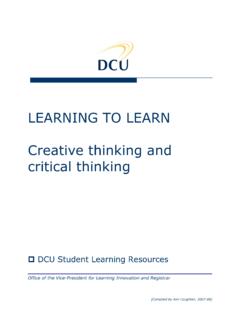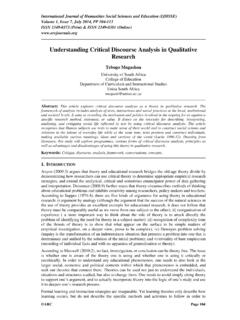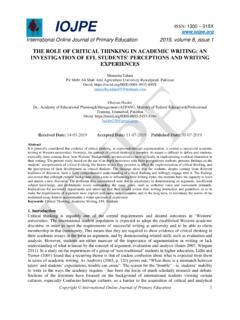Transcription of THE ARMY PEOPLE STRATEGY
1 THE ARMY PEOPLE STRATEGY OCTOBER 2019 2 Winning matters, and PEOPLE are my number one priority. PEOPLE are our Soldiers Regular Army, National Guard and Reserve - their Families, Civilians, and Soldiers for Life Retirees and Veterans. We win through our PEOPLE , and PEOPLE will drive success in our Readiness, Modernization and Reform priorities. We must take care of our - General James McConville, 40th Chief of Staff, Army The Army s PEOPLE - Soldiers from the Total Army Active, Guard, and Reserves who form cohesive teams that are trained, disciplined and fit, and can win on the battlefield. - Families that have quality services that enable them to be ready for any mission their Soldiers are called upon to accomplish. - Army Civilians who form the institutional backbone of the Army and are an integral part of the Army enterprise. - Soldiers for Life - our Retirees and Veterans whose service we honor and ask that they continue their mission to hire fellow veterans and inspire young Americans to serve.
2 I. INTRODUCTION The Total Army must remain ready as the world s premier combat force. That readiness relies upon PEOPLE . After all, equipment does not learn, understand, innovate, build cohesive teams, or exercise judgment PEOPLE do. Human capabilities such as resiliency, critical thinking, comfort with ambiguity, and the ability to accept prudent risk and adjust rapidly all define our profession. The Army PEOPLE STRATEGY describes how we will shift from simply distributing personnel to more deliberately managing the talents of our Soldiers and Civilians. This means creating a 21st century talent management system with policies, programs, and processes that recognize and capitalize the unique knowledge, skills, and behaviors possessed by every member of the Army team, allowing us to employ each to maximum effect. Recognizing that our Soldiers and Civilians should have the best quality of life possible, Army Senior Leaders are also prioritizing improvements in our housing and barracks, healthcare, childcare, spouse employment and permanent change of station moves.
3 The Army Mission is unchanged: To deploy, fight, and win our Nation s wars by providing ready, prompt, and sustained land dominance by Army forces across the full spectrum of conflict as part of the Joint Force. 3 The Army PEOPLE STRATEGY mission and vision are clear The Total Army will acquire, develop, employ, and retain the diversity of Soldier and Civilian talent needed to achieve Total Army readiness. Our vision is to build cohesive teams for the Joint Force by maximizing the talents of our PEOPLE , the Army s greatest strength and most important weapon system. The Army PEOPLE STRATEGY is foundational to the readiness, modernization, and reform efforts described in the Army STRATEGY . With the right PEOPLE , in the right place, at the right time, our Army will successfully deploy, fight, and win in multi-domain operations (MDO) and excel in support of the Joint Force. It is our PEOPLE who provide us with an enduring advantage to remain the world s most ready, lethal, and capable land combat force.
4 II. STRATEGIC ENVIRONMENT The National Defense STRATEGY and the Army STRATEGY both point out that the global security environment is increasingly complex and shaped by several emergent trends. A. Threat Trends In the past, the Army has enjoyed a competitive advantage over any potential adversary in capital, technology, and PEOPLE . More recently, however, near-peer, revisionist great powers such as China and Russia have improved their large-scale ground combat capabilities by increasing their capital expenditures and reducing the technology gap, leaving PEOPLE as our enduring strategic advantage. Additionally, new challenges to the international order, regional state adversaries and their proxy networks, terrorists, trans-national criminal organizations, and state and non-state cyber hackers are all threats we must be prepared to face simultaneously across multiple domains. B. Non-threat Trends Shifting generational values and technological advances are changing the very nature of work itself.
5 In the last 50 years, the American labor market, where the Army competes for talent, has also changed. The information-age economy demands a far higher share of knowledge workers, PEOPLE who add value and increase productivity through creative thinking and innovation. The limited supply of these workers has made talent poaching standard practice among American companies. As a result, the era when bosses unilaterally made employment decisions is over. Today s knowledge workers value steady employability more than steady employment, and the modern labor marketplace makes it possible for them to change firms repeatedly in pursuit of greater job satisfaction and personal fulfillment. To compete in this high-demand, high-skill labor market, American employers have reinvented their PEOPLE practices. Today s highly successful businesses abandoned industrial-era labor management practices long ago. They moved to 4 talent management, which, rather than treating PEOPLE as interchangeable parts, leverages the unique productive capacities of each person.
6 The Army is doing the same to remain competitive in the domestic labor market. C. Assumptions 1. The United States Army will remain an all-volunteer military force. 2. The Army budget will be predictable, adequate, sustained, and timely through 2028. 3. Global demand for military presence will remain stable to 2028. 4. Intense competition for resources, both fiscal and human, will remain a significant challenge. 5. The Army will increasingly operate with joint, inter-agency, and multi-national partners. D. Risk The Army must make PEOPLE the centerpiece of its competitive advantage by prioritizing human capital investment or risk losing its overmatch capabilities to potential adversaries. III. STRATEGIC APPROACH Talent management is transformational, increasing organizational agility, focusing on productivity, and manifests as readiness and lethality. It also integrates all PEOPLE practices, generating a positive effect on organizational outcomes and leveraging each individual s knowledge, skills, behaviors, and preferences (KSB-Ps) for the mutual benefit of the Army and the individual.
7 Lastly, this approach supports Army STRATEGY LOE 3, Reform, which calls for a talent management-based personnel system. To achieve our vision of cohesive teams for the Joint Force, the Army PEOPLE STRATEGY pursues four Strategic Outcomes, supported by four Critical Enablers, along four Lines of Effort: Acquire, Develop, Employ, and Retain Talent. 5 Figure 1. Strategic Approach through 2028 A. Strategic Outcomes By 2028 our desired end-state for each outcome is: 1. Ready The Army uses a range of technologies, incentives, programs, and policies to identify the talents of its PEOPLE and the talent demands of its organizations in timely, accurate, and granular detail. It applies data-driven analytical tools to its talent employment and development efforts. This data drives a dynamic and accurate long-term workforce planning system which reduces talent gaps and increases overall Army readiness.
8 It also enables the Army to rapidly build appropriately talented special mission teams - cohesive teams that are trained, disciplined, and fit to win. 2. Professional The Army is a profession, a highly expert, certified, and credentialed force resulting from years of increasingly rigorous training, education, and leader development. Its PEOPLE treat one another with dignity and respect, retaining the trust and confidence of both the American PEOPLE and each other. Army professionals are PEOPLE of character, presence, and intellect, committed to reflective practice and continuous learning. They share a powerful and enduring identity as lifelong members of the Army team. 3. Diverse The Army is committed to equality of opportunity, providing all of our talented PEOPLE with fulfilling and rewarding professional careers. As an 6 inclusive and representative American institution, we ensure that our PEOPLE possess a diversity of talent knowledge, skills, behaviors, and preferences drawn from all corners of our country and its vibrant, diverse population.
9 4. Integrated The Army has overcome legal, cultural, and technological barriers to fully harmonize the efforts and capabilities of its Total Force: Active, Guard, Reserve Soldiers, and Civilians. This transformation has dramatically increased workforce permeability between the Active, Guard, and Reserve, between Soldiers and Civilians, to the benefit of both the Army and its PEOPLE . B. Lines of Effort The following Lines of Effort (LOEs) organize our movement towards our Strategic Outcomes. Each disaggregates into three supporting objective areas, providing a framework for the alignment of specific initiatives in follow-on implementation plans. 1. Acquire Talent (LOE 1) Lead Integrator: TRADOC / USMA (Military), Army G-1 (Civilian). Identify and recruit the diverse military and civilian talents needed to organize, train, and equip a force ready for prompt and sustained ground combat.
10 Creating a robust pipeline of new talent into the Total Army is our main effort through 2028 because it will ensure that we have the breadth and depth of talent needed for the MDO-capable force of 2035 envisioned by the Army STRATEGY . The Army must place a greater emphasis on acquiring the right PEOPLE through better screening and assessments allowing us save and reinvest valuable resources by reducing attrition. To guarantee innovation and accessions of the right talent, we must align talented accessions leaders and instructors to our generating force and incentivize them accordingly. a. Market Employ innovative new techniques to increase awareness of the breadth of Army service opportunities and to shape preferences, targeting efforts against specific and diverse talent pools in the American labor market where critical talent is most likely to reside. b. Recruit Screen and select potential Soldiers and Civilians who actively respond to Army marketing efforts and seek service with the Army.












